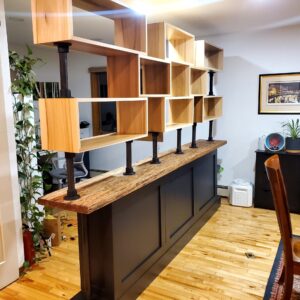Woodworking Wisdom: 6 Leadership Lessons Discovered in the Workshop of Adversity

 Our house has a lovely, open-format layout. The only walls we have downstairs are holding up the upstairs. This is great for get-togethers. Not so great when trying to hide from the children.
Our house has a lovely, open-format layout. The only walls we have downstairs are holding up the upstairs. This is great for get-togethers. Not so great when trying to hide from the children.
During the dark days of the COVID lockdowns, my wife and I needed a separate office. The house used to have one, but a previous owner had taken the wall down. For various reasons, we didn’t want to build a solid wall. Instead, we decided that a room divider would suit our purposes.
But I didn’t want to spend $1,000 to buy a room divider. Especially not when I could spend $10,000 and build one myself. Not that I knew how.
What I lacked in skill, I made up for in undeserved confidence.
About a month ago, three and half years after the start, I finally finished the project. This provided a lot of time to think about my choices. Here is what I discovered (as applied to leadership):
1. Vision is easier to write than build
Years ago, author Jim Collins encouraged organizations to develop “Big Hairy Audacious Goals.” Leaders began to imagine the biggest vision possible. Unintentionally, they created vision statements unmoored from reality.
Very rarely do businesses set vision statements that are too small. The tendency is to either have no vision at all or one that is improbably grandiose. Both are errors.
I often run into businesses that have colossal vision statements that mock them. For example, a small, struggling company that envisions itself as the ‘global leader’ in their industry. It would be more helpful and realistic to envision becoming a local leader first. Or simply being profitable.
In my case, I’m glad that I pursued this large vision. And I accomplished it. It launched a hobby that I enjoy. But I wildly missed the mark of creating an office space that would support remote work during COVID. As far as personal goals went – it was fine. But for business goals – it was a miss.
I encourage setting a vision that is just over the horizon. Not the biggest dream you can imagine. Your vision should be larger or more challenging than where you are right now. But it should also make sense to pursue.
2. Good plans are important
One of my biggest challenges was that I didn’t know how to build this divider. I didn’t even know how to draw decent plans. The plans I sketched stopped making sense once I started building. I often couldn’t find the materials I needed, didn’t have the tools, or didn’t know how to use them.
Good plans would have saved me at least two and a half years, a lot of false starts, and wasted materials.
3. Plans go sideways
Even if I had good plans, there would have been challenges. Building anything during COVID was hard because materials weren’t available. My skills didn’t match my ambition. I wasn’t equipped. I had other responsibilities that took up time. And so on.
Plans went sideways. That’s normal. Plans should be flexible and adjustable. But that’s different than not having a plan. And changing the plan is different than changing the goal. Your plans will adjust and evolve. But they should keep pointing you towards your goal.
What I eventually built is different than what I originally planned. But it’s substantively the same thing.
4. Perfection is the enemy
I wanted to go from no real woodworking experience to building centerpiece furniture. And I wanted it to look perfect. It should be impressive and without mistakes.
Unfortunately, the fear of making mistakes didn’t prevent mistakes. But it did slow me down.
What helped was learning to make and learn from mistakes faster. The quicker I moved through those mistake cycles, the better my work became. But I had to be willing to make mistakes.
5. Mistakes are still lousy
That being said, mistakes still have consequences. Some of the mistakes I made early in the project had downstream impacts that showed up much later. They were expensive and time-consuming to fix.
Many of my mistakes could have been avoided if I had taken the time to learn some of the basic skills I needed earlier. I would have made those mistakes in smaller, less costly contexts.
Mistakes can be good teachers – but there are other, better teachers to take advantage of.
This brings me to…
6. It’s easier with help
I now know much more than I did. The main lesson is: How much I don’t know. Asking for help and getting training would all have paid off in the long run. I’m sure I would have completed the project faster and at a lower cost if I had received both or either.
Directly after completing the project, I started a woodworking course. One that walks through the basics and doesn’t skip steps.
Some leaders are natural visionaries and it is easy for them to leap before they look. Others are natural stewards and they want things to be ‘right.’ There aren’t as many leaders who, like me, try to do both at the same time. Those who take on too much but also want to be perfect at it.
But whatever tendency you have – you’ll be faster and more successful with help.
- What kind of help do you need?
- Who can provide that to you?
- What is the benefit of getting the help you need now?
- What is the likely cost or risk of not getting help?
Take good care,
Christian
Article Categories
Popular articles

Download my free 10-page eBook:
How To Accomplish More Without Doing More:
Eight Proven Strategies To Change Your Life
Discover how to save eight hours during your workweek-even if you're too busy to even think about it. The resource every maxed out executive needs.